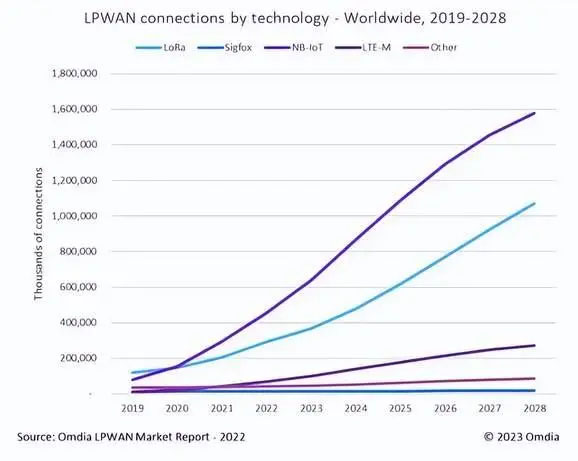LPWA IoT to grow at 23% CAGR over the next 5 years NB-IoT and LoRa are leading the way
New research from market research firm Omdia indicates that the number of low-power wide-area (LPWA) IoT network connections will grow at a compound annual growth rate of 23 percent between now and 2028, driven by the growth of NB-IoT and LoRaWAN technologies. NB-IoT and LoRa will account for 87 percent of all LPWA-type IoT connections.
Omdia estimates that these two technologies currently account for 85 percent of LPWA-IoT connections worldwide; so their market share growth is only two percentage points. But Omdia's five-year compound annual growth rate forecast for the LPWA network market is 23 percent, indicating significant growth over that period and suggesting that their combined growth will outpace the index and drive the overall market forward.
Shobhit Srivastava, senior principal analyst at Omdia, said cellular-based NB-IoT and non-cellular-based LoRaWAN are in a better position to grow compared to their respective traditional competitors, LTE-M and Sigfox. He said, "Because there are enough differences between the two technologies, both are expected to be successful until the end of Omdia's forecast period in 2028."

The report notes that the growth of NB-IoT remains a small story, largely confined to the Chinese market, where more than 90 percent of global NB-IoT connections are located by the end of 2022 and are typically deployed in fixed use cases such as utility metering and smart city monitoring.Shobhit Srivastava commented, "In markets outside of China, NB-IoT adoption has been slow ...... China will continue to be a major driver of NB-IoT adoption for the foreseeable future."
But Omdia said the renewed interest in NB-IoT in Europe shows that there is room for NB-IoT to grow outside of China as well. He noted that operators such as Telefonica and Deutsche Telekom are investing in satellite-based NB-IoT to reach remote areas, and government agencies such as Spain's National Transport Authority (DGT) will deploy NB-IoT for early warning beacons starting in 2026.
For LoRaWAN, Omdia concludes, "LoRaWAN has experienced several years of undisputed growth as the technology builds its momentum and matures. loRaWAN's future success continues to depend on it having a differentiated offering and value that NB-IoT cannot easily match. loRa is unmatched for companies deploying IoT applications LoRa offers unparalleled accessibility for companies deploying IoT applications. This accessibility makes LoRaWAN one of the favorites of small developers, creator communities and OTT IoT networks."
Related Article
-

What is the Internet of Things? Internet of Things Overview and Detailed Explanation
-

Enterprise IoT spending growth slows: to grow 12% to $301 billion this year, study says
-

Chinese tech firm Baidu's Apollo GO full-fledged commercial application into Wuhan online taxi
-

Main Application Scenarios of Internet of Things
-

Introduction of NB-IOT large-diameter intelligent remote water meter
-

AIOT system architecture and communication protocol

